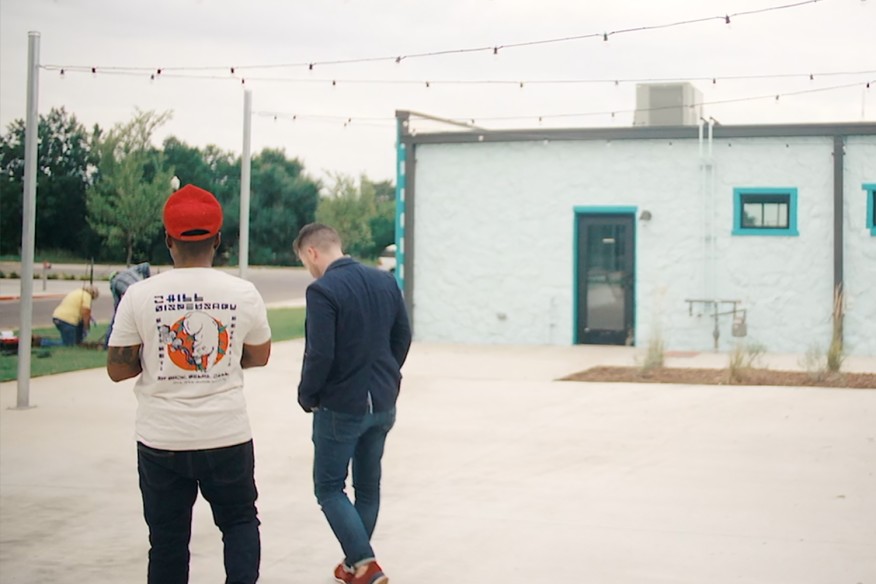Like the residents of many other one-time social and economic centers of African American life, the residents of Oklahoma City’s Eastside experienced redlining and segregation throughout the 20th century. In 2016, hoping to reignite interest in the historically marginalized part of town, local developer Sandino L. Thompson, activist and rapper Jabee Williams, and Jonathan Dodson of Pivot Project, an Oklahoma City development company with a socially-driven mission, had an idea. They wanted to bring business back to the Eastside.
Soon, design firm Gardner Architects was on board. The Gardner and Pivot teams, previous collaborators on challenging projects throughout city, joined a real estate broker on a car ride through the Eastside, looking for just the right site for a new commercial and social hub. Together with community leaders, they selected an abandoned strip mall on Northeast 23rd Street for what would ultimately become the EastPoint Project.
“What’s been interesting is that whole evolution of the idea has really stuck,” says Jeremy Gardner, AIA, principal at Gardner Architects, about the dedication the community has shown throughout the process. Early in the project, developers and entrepreneurs drummed up enough excitement to get the city government involved “just by sheer will.” He adds, “I’m most proud of the fact that [this project] didn’t die on paper.”
Interest from potential tenants—including retail entrepreneurs, restaurateurs, and doctors—was strong from the outset, but Gardner explains there were some hurdles along the way. “A lot of the [initial design] solutions were geared towards those particular businesses,” he says. “But given the duration of how long this project took to get funding, get financed, get city approvals—some of those tenants moved on.” Thompson, Williams, and Pivot’s Jonathan Dodson sought investors and worked to gain buy-in from other stakeholders in the neighborhood, an effort that paid off as the Gardner team got to work.
Envisioning a structure that could accommodate current tenants but would be flexible and versatile enough to adapt to changing needs was a priority for Hana Waugh, AIA, the lead project manager and designer from Gardner. “One thing I’ve heard some of the community’s members hope for with this development is that it would be a springboard,” she says. “So, maybe it’s the first space that these tenants are able to [occupy] because it’s an economical option. And then in the future, they’re able to move onto bigger and better things.”
With the expertise of Lingo Construction to execute their vision, Gardner pushed through a series of design challenges. “Different veneers and diff erent uses have cannibalized a lot of the structure over time,” he says. Gutting and overhauling a strip mall that had such little attention paid to it over the years was a massive undertaking, but one that made room for unique opportunities. The centerpiece of the renewed block of commercial units is a covered breezeway, designed to promote connectivity between a back parking area and the retail fronts.
Gardner is excited that the breezeway will provide various retail opportunities, as well as some social cohesion for tenants. “It allowed us to incorporate even more types of entrepreneurs,” he says. “You can get a 500-square-foot tenant and you could get a 3,000-square-foot tenant.” After nearly three years of design and construction, those tenants are finally moving in and setting up shop. Waugh and her colleagues at Gardner, as well as her husband, filmmaker Weston Waugh, recognized they had a story that was worth sharing with a mass audience earlier this year. They entered—and went on to win— the 2019 AIA Film Challenge. Their short film, named The EastPoint Project, brings the Northeast 23rd Street development into focus, featuring interviews with Ward 7 city council member Nikki Nice, Gardner, Dodson, Williams, and Thompson, who discuss the project’s process, outcomes, and what it represents.
The EastPoint Project is a standard for equitable development that Pivot Project and Gardner Architects hope will continue in Oklahoma City. “We’re hoping that this project is a catalyst,” Waugh says. “I’m really proud to be a part of something that could be the first of many improvements in a community that will really feel an impact.”
The message of grand prize–winning short documentary The EastPoint Project is clear and simple: Invest in your community and great things will come. “In addition to bringing in wealth and getting folks to invest where there’s really been a lot of disinvestment,” says Thompson in the film, “we’re also creating opportunities for people who exist, who are here, to be able to persist and be able to sustain themselves.”

